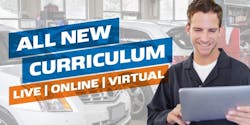How does the nation’s leading collision repair training program deal with the mind-blowing complexities of modern vehicles?
The answer is simple: By returning to its roots, of course.
“I-CAR was formed to deal with the unibody,” says Jason Bartanen, Director of Industry Technical Relations at I-CAR, “and the curriculum update brought us back to that a bit. These vehicles are even more complex!”
Bartanen describes himself as part of the “car guy team.” At I-CAR, he works with manufacturers on all the technical aspects of approved collision repair. One of his colleagues and counterparts at I-CAR is Joshua McFarlin, Director of Curriculum and Product Development. Together, they’re part of a team transforming the ways in which I-CAR is evolving in order to serve the technicians of tomorrow.
The new curriculum has been over four years in the making. Besides updating how and why Gold Class and Platinum recognitions are achieved, I-CAR has done something even more ambitious: overhauled the very heart of its technician training. From its Professional Development Program (PDP) to the I-CAR In-Shop Knowledge Assessment, Welding Training & Certification, Hands-On Skills Development, and even its Industry Training Alliance accreditation program, I-CAR is meeting its technicians—and the industry they serve—where they need it most.
Or, rather, when—right here in the 21st century.
In his book The Medium is the Message, media and tech guru Marshall McLuhan writes, “Nothing can be further from the spirit of the new technology than ‘a place for everything and everything in its place.’ You can’t go home again.” I-CAR has taken that spirit to heart.
“Using the different delivery mediums is the key to our program,” Bartanen says.
“People were recognizing that they need education, they need training, that the vehicle is different, and Josh’s approach—critical adult learning theory—was a great blend. The timing couldn’t have been better.”
Future courses will be more interactive, with far less course-to-course redundancy. Training programs will be built around knowledge and skills-based protocols developed from extensive industry input and design.
“It’s a blended curriculum,” McFarlin says.
“We want to deliver the right content in the right space. We made some ground rules: an online course shouldn’t be more than an hour, and even that’s stretching the limits.”
Previously, courses stretched to as long as three hours—an eternity in today’s modern marketplace.
“Our virtual courses shouldn’t exceed 90 minutes,” McFarlin says, “and instructor-led classroom courses should still hit three hours, but the key is now face-to-face interaction. Roleplaying—as cliche as that might sound—is a valuable piece, and we can now simulate customer and insurance interactions, for example, and foster those relationships. That just doesn’t work online.”
McFarlin says simply following those simple rules represents a massive change in how I-CAR training is implemented, delivered, and ultimately assessed.
“We also wanted to introduce more hands-on,” he says, “and historically that’s difficult; the instructors had to be trained differently and we needed more class sites. Now we call them Hands-On Skills Development.” Hands-On Skills Development courses are performed in the shop on the same equipment that will be used for actual repairs.
Making better use of the delivery mediums—online, virtual, live, or hands-on—and breaking them up into smaller pieces both makes all the courses more engaging and empowers maximum learning. McFarlin notes that proper application of corrosion protection, for example, hasn’t changed very much, so that can still be delivered online. An instructor doesn’t need to teach that in person, and it frees them up to administer more valuable lessons, skills, and makes better use of everyone’s time.
“We want to make the best use of hands-on training,” Bartanen adds.
“We’re dealing with collision professionals who have been fantastic hands-on learners their entire lives. It’s kinesthetic, so a class delivered online is not always going to be the best way—or the only way—to deliver lessons that really need to be seen, felt, and applied. The hands-on component is an important part of our future at I-CAR.”
Learn, prove, and get to work: that’s the goal. Eliminating redundancies while updating the training and delivery mediums will catalyze everything about the future of I-CAR training.
"More advanced employees will benefit from in-shop knowledge assessments,” McFarlin adds.
“We’ll send an assessor out for a face-to-face conversation to document what they know; the objective is to avoid a single course when they already have the knowledge in their head. It’s not meant to be a test—it’s a conversation to ascertain what they know so we can be prescriptive about which courses will be appropriate so the training you take is what you need instead of just checking boxes with I-CAR. That assessment allows you to demonstrate your knowledge to avoid the courses in Pro Level I.”
As the industry standard in training for nearly 40 years, shop owners and technicians can take confidence in knowing that I-CAR’s curriculum, program and service technology enhancements are designed to lead your shop—and the industry—through this extraordinary era of change, ensuring your shop’s ability to thrive in the months and years ahead.
This enhanced curriculum is launching soon. Learn more about this and what else I-CAR will be launching at i-cartraintogain.com/knowledge.
About the Author
Sponsored Content
The views and opinions expressed in this piece do not necessarily reflect those of 10 Missions Media and its associated brands.
